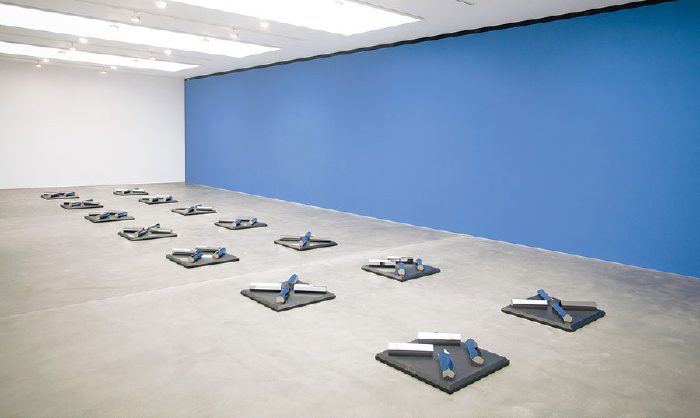ART-PRESENTATION: Walter de Maria
 Walter de Maria bridged Minimalism, Conceptual Art, Land Art, and Installation Art, creating interactive sculptural installations and providing conceptual underpinnings to larger-scale sculptural work. In later projects he also connected viewers to nature by either embedding visual elements in nature itself, or by bringing components of nature inside gallery spaces.
Walter de Maria bridged Minimalism, Conceptual Art, Land Art, and Installation Art, creating interactive sculptural installations and providing conceptual underpinnings to larger-scale sculptural work. In later projects he also connected viewers to nature by either embedding visual elements in nature itself, or by bringing components of nature inside gallery spaces.
By Efi Michalarou
Photo: Gagosian Gallery Archive
Drawings and sculptures by Walter de Maria, from the first four decades of his career, including the never-before seen “Truth/Beauty” (1993–2016), are in presentation at the Gagosian Gallery in London. In 1960, Walter de Maria moved to New York City and began constructing static sculptures, unpainted, handmade wooden boxes, often with words or instructions written in pencil on their exteriors and accompanied by wooden balls. “One Hundred Activities for Rich and Poor” (1960–61), an eight-page drawing from the Walter De Maria Estate, exemplifies his engagement with Conceptual art, and his desire to give these abstract ideas aesthetic presence. Drawn in primary-colored inks, crayon, and pencil, this early work is a list devoid of practical functionality yet open to innumerable conceptual possibilities. The “Open Polygon” series (1973–74) is represented by four stainless steel shapes set in a row that progress from a pentagon to an octagon. Each shape is defined by a recessed track containing a steel ball. The series was one of De Maria’s earliest employments of the polygonal steel form, which he would variously incorporate into both horizontal and vertical sculptures. The “Pure Polygon Serie”s (1975–76), seven pencil drawings that begin with a triangle and follow with the next six shapes in succession, show two-dimensional geometric forms on the threshold of visibility. Never seen before, “Truth / Beauty”, a series of fourteen sculptures in seven pairs, was conceived and partly constructed in the early ‘90s, with the bases and assembly completed posthumously by the Estate according to De Maria’s wishes. The series expands upon his persistent attention to permutations of rods, polygons, and numbers. Each pair consists of two arrangements of four rods upon granite bases: one composition is a chevron pattern and the other resembles an “X.” Each base has “TRUTH” and “BEAUTY” engraved on opposite sides. The first pair comprises five-sided rods, and the rods increase by two sides with each successive couple, culminating in seventeen-sided rods.
Info: Gagosian Gallery, 6-24 Britannia Street, London, Duration: 26/5-30/7/16, Days & Hours: Tue-Sat 10:00-18:00, www.gagosian.com
